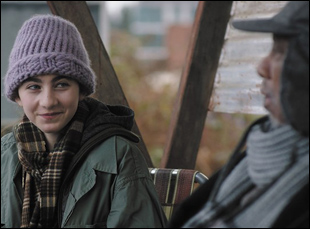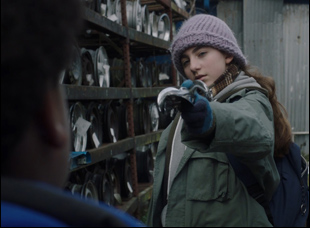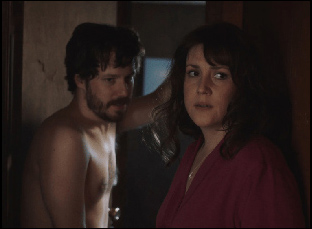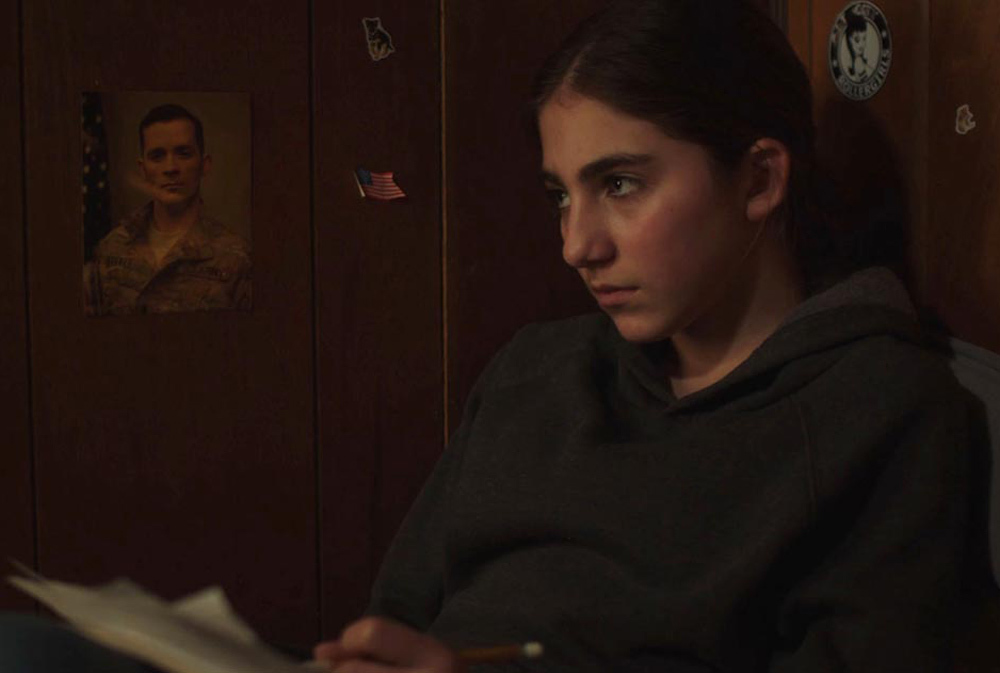On the very pillow where Sadie (Sophia Mitri Schloss) rests her head at night in the latest film from Megan Griffiths, there are camouflage sheets with a skull and crossbones pattern that are a nod to the 13-year-old’s father serving in the military. Although the bedding gives Sadie extra comfort, it’s bound to get under your skin, just the sly suggestion that violence has quite literally invaded the place where she sleeps that’s indicative of the world that the “Eden” writer/director sees as our present reality in which a culture steeped in mass shootings and overseas wars have an impact that may be so sly and insidious that it’s imperceptible if you’re not watching out for it. Surely, it’s why Sadie acts so aggressively towards her mother Rae (Melanie Lynskey), who can rarely afford to be away from working as a nurse to keep a roof over their head, or Cyrus (John Gallagher Jr.), their new neighbor at the trailer park who she sees as competition for her father when it becomes obvious he takes an interest in Rae.
Yet while Sadie’s anger fills the void her father left when he was deployed, Griffiths finds intrigue in examining how it may be misplaced, as the soldier’s tour of duty increasingly looks like an escape from an equally treacherous minefield back home, at least in Rae’s eyes, and how casual neglect has touched the lives of everyone living on the edge of town at Shady Plains where the only things capable of being upwardly mobile are the homes. The rare director to be as invested in crafting a crackling entertainment as a socially conscious slice of life, Griffiths makes “Sadie” as energetic and reverberant as the guitar licks she draws on from Pearl Jam’s Mike McCready in his first time composing for a narrative feature, observing her young lead gradually lose her innocence as she tinkers around with Milk of Magnesia and the firearms Rae keeps around the house as protection, uncertain of the consequences but looking for some measure of control in at a time in her life when she seems to have none.
Although Sadie grapples throughout with gaining the upper hand, both the pinpoint emotional precision in Griffiths’ direction and a powerful turn by the young Schloss, as well as everyone else in the talented ensemble the film has assembled, exude a determination and confidence in the story that’s being told that is bound to win your over. Following its premiere at SXSW earlier this year, “Sadie” is arriving in theaters around the country this week and we were fortunate to speak to Griffiths about the production which has been in the works for nearly a decade, fostering a collaborative environment on set and how a film that she started writing in 2009 is sadly prescient in times we’re in now.

I did several drafts in the first several years I was working on it and it has remained fairly similar. Over that time, I worked with a friend named David Lipson, who would read drafts and have these great, long conversations about the story and characters, as would Lacey Leavitt, who has produced for nine years on this project and was constantly reading and giving notes. Between those two, we found the script and it’s hasn’t changed much since 2012 or ’13, but I did a little bit of a spruce up when I knew who all the actors were going to be to make sure it fit them.
Melanie was on for a couple of years and nothing much had to change for her. She can sync into things so seamlessly and it was a good role for her from the get-go. But I knew I couldn’t cast the kids until we had a start date because for nine years, I watched people age out of this role who I thought would be good Sadies – I have a long list of Sadies who can vote now or drink now. [laughs] Elle Fanning, Chloe Moretz – all these people who were young at one point when we were making it and another year would pass and we couldn’t get it together. I knew of Sophia because she was in another big Seattle movie last year called “Lane 1974” and she’d been in this film called “Desert Cathedral” that I’d seen her in when she was eight and was super-impressed. I thought of her as a potential Sadie then and [said] “Well, if it takes us a while, maybe that’ll be Sadie.” And then ultimately, when we knew we were starting in January of 2017, I knew she was just a capable, strong actress when it came time.
It’s a really tricky character for any number of reasons, but she’s quite manipulative and yet you obviously sympathize with her. What was it like striking that balance?
Yeah, I never like it when it’s easy to step away from someone who makes bad choices in a film. I like it when it’s complicated for an audience to reconcile the person and the action because I honestly feel like we should all work a little harder to understand people we don’t agree with, so to accomplish that, you usually need actors with a certain level of charisma and likability and who can play the roles with heart first and then it makes the audience work a little harder to understand the decision-making.
I had made a few films with, as people like to say, “damaged women characters” and it’s hard sometimes for audiences. We don’t get very many of these complicated female characters driving a story culturally. We’re very used to accepting flawed male characters in films and people tend to shut down a little quicker with a flawed female character, so experiencing that pushback a few times, I was thinking about it going in and Sophia is a delightful, vivacious, upbeat child in real life, and I knew she would sync into Sadie, but she’s still so dynamic and watchable and there’s so much going on behind her eyes that I felt like people just would like her and want her to get out of this mess. That was part of the casting process was to find somebody people won’t write off.

It felt like a very organic choice because our perception of trailer parks is as somewhere where people have ended up or as a transitional space and it felt appropriate for these characters, especially Cyrus who’s in such a transition in his life, to be there. When we finally knew when we were shooting, our location manager had actually just scouted trailer parks for “Twin Peaks” for David Lynch, so he showed us all these ones that he had found which didn’t feel quite right. Then as we were finishing up our scout, the production designer Ben Blankenship was like, “You know what? Go up this street.” He and I are like aesthetic twinsies and he remembered this place from another shoot that might be right, so I was like, “Yes, let’s go where he thinks we should go.” When we looked at it, it was so perfect and there were three vacant trailers, so [I thought] we could move Sadie’s family into one of them, [Danielle Brooks’ character] Carla’s family into another and use one for staging, so it was production friendly and it was aesthetically perfect, but we did have to be careful about how we shot it because it was surrounded by new development.
Did the limitations of working in tight spaces inform it? I really loved the “I Love You” scene where you’re shooting up and into the window of one of the trailers.
It was definitely challenging. Those rooms are tiny and we could barely fit the actors in there, much less with the camera and the focus puller and everything. I actually said, “Maybe we should build the Sadie set at least” so we’d have a little more leeway, but then T.J. Williams, who shot it, [said he] welcomed the challenges of it because He thought it’d aesthetically sell the story better and add something to the claustrophobia the characters are feeling. So we all just switched gears and went into shooting on location. The fact that we had the exterior of the trailer park and we could shoot out the windows, all of a sudden, we didn’t have to be as tricky as you have to be when you’re shooting on sets.

They’re genuinely truly good people and they were not alone. Tony Hale is and Sophia is and Keith Williams is a delight and Tee Dennard who plays Deak – top to bottom, this cast is just wonderful and if course, we have this Seattle crew that I know so well and who I have such good, strong relationships with and who come ready to support me and make my movie even when it’s freezing and raining. One day I was walking around on set just like looking at the grips and I’m like I know why I’m here – this is such an important movie to me – but it wasn’t like everybody was getting big commercial day rates, [so I was thinking] like bless your hearts for standing there in the rain. And if we didn’t work in the rain, we wouldn’t be able to work at all in Seattle, so we’re used to it, but it was a really solid, amazing group of really amazing, supportive crew and cast.
Was there a particularly crazy day of shooting on this?
What pops to mind wasn’t necessarily a challenge, but more a moment of serendipity because we were shooting the scene where John Gallagher Jr’s character Cyrus leaves this fight he’s having with Rae at the hospital and he walks to his car and he gets in and in the script, it says he’s thinking and a plane flies overhead and he looks at it and it’s a reflective moment for his character. I just thought, “Well, we’re not going to be able to make that happen, so that’ll be part of the VFX budget. We’ll put in the reflection of a plane in the windshield.” [When] we were doing take two of it, [John] couldn’t see the sky, but he was looking at a point on the building where the eyeline looked right and right at the moment before he looked up, you see this plane that lit up by the sun reflected in the windshield. He looks up at it, like it’s caught his eye and then it just goes out of frame and we were all just like, “Did that just really happen?” I had a VFX budget meeting at lunch that day and I was like, “Well, we can cross one of those off the list.” [laughs] So that was awesome. Every time I watch it, I’m like, “That’s pretty cool.”
Speaking of cool, how do you get Mike McCready come on to work on the score?
My friend Kate Bayley had brought Mike McCready to a “Lucky Them” screening and I was really a bit starstruck knowing he was there. But he was a big fan of it and said it really captured the music scene of Seattle, which really made me swoon. He had just been starting to move into composing for film and he mentioned then that he was interested in it and we had seen each other a few times since because we both live in Seattle and he always mentioned, “Let me know if you have anything coming up…” As we were getting “Sadie” together, I thought “Maybe this is the right one” for that to happen, so I called him up and he just jumped onboard and brought in Molly Sides and Whitney Petty from Thunderpussy, who he’s been a huge champion of band and the three of them, with Josh Evans, who’s a Pearl Jam engineer, just holed up in the studio and gave us all this great stuff. We just kept receiving all these great batches of music while we were in the edit.
I also noticed the logo of the great Seattle music label Light in the Attic at the end. How did you work with them?
I know Matt Sullivan, who started Light in the Attic, and Grant Olsen, who is a producer there, and I had lunch when I was in L.A. at one point and he said “If you need anything, hit us up.” We didn’t have a ton of need because Mike was creating so much of the score, but we needed a few pieces here and there and Grant was so great at finding them. For all the bar scenes, we ended up using a Seattle artist named Grace Love and the True Loves because it just felt like it was what Danielle Brooks’ character might listen to when she was bartending. I didn’t even realize until a year after we were collaborating that Grant was also responsible for the bands Arthur & Yu and Gold Leaves and those two bands are probably the albums I listen to more than any other albums I have, so I had to geek out on him when I learned.
What’s it like to be putting this out into the world now?
I’m so glad to have finally made it because it’s been on my mind for nine years and every time something awful happens, it just reminds me of this story that I wanted to tell. It’s a response to watching so many kids come of age in a culture that’s so filled with violence in every corner of our lives. There’s guns everywhere. There’s a war still going on, and [guns are] infiltrating our schools at this point and what worries me about the way it’s portrayed in the media is that it tends to be fairly consequence-free. There’s a lot of people pulling triggers and a lot of people falling down, but there’s not a lot of people processing the fact that a life has just ended.
It’s not like I feel we shouldn’t have violence portrayed in media because it’s part of our life, but there’s no connection to the act that has happened that is really seen in so many of these films and it takes away the seriousness of it for so many people that are growing up. They just don’t think that having a gun and pulling a trigger is anything [after] they’ve seen a million people do it over the course of their lives. That’s worrying to me because I live in this world too and I’d like it to be a safer place for all of us. And a more humane place.
“Sadie” opens on October 12th in Los Angeles at the Arena Cinelounge and in New York at Cinema Village. A full list of screenings is here.




